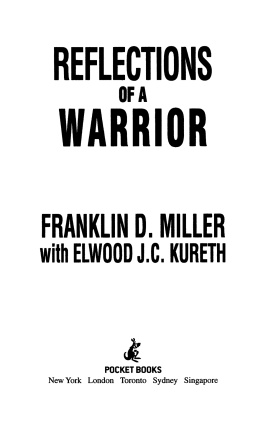Also by Richard Strozzi-Heckler
The Anatomy of Change: A Way to Move
Through Lifes Transitions
Holding the Center: Sanctuary in a Time of Confusion
The Leadership Dojo: Build Your Foundation
as an Exemplary Leader
Anthologies edited by Richard Strozzi-Heckler
Aikido and the New Warrior
Being Human at Work: Bringing Somatic Intelligence
into Your Professional Life
Copyright 1990, 1992, 2003, 2007 by Richard Strozzi-Heckler. All rights reserved. No portion of this book, except for brief review, may be reproduced, stored in a retrieval system, or transmitted in any form or by any meanselectronic, mechanical, photocopying, recording, or otherwisewithout written permission of the publisher. For information contact Blue Snake Books c/o North Atlantic Books.
Published by Blue Snake Books
Blue Snake Books
are distributed by
North Atlantic Books
P.O. Box 12327
Berkeley, California 94712
Cover photo istockphoto.com/photog Clay Cartwright
Cover design by Brad Greene
In Search of the Warrior Spirit is sponsored by the Society for the Study of Native Arts and Sciences, a nonprofit educational corporation whose goals are to develop an educational and crosscultural perspective linking various scientific, social, and artistic fields; to nurture a holistic view of arts, sciences, humanities, and healing; and to publish and distribute literature on the relationship of mind, body, and nature.
Authors Note: The names of the soldiers, the team designation, as well as the Army Post have been changed.
Blue Snake Books publications are available through most bookstores. For further information, call 800-733-3000 or visit our websites at www.northatlanticbooks.com or www.bluesnakebooks.com.
Library of Congress Cataloging-in-Publication Data
Strozzi-Heckler, Richard.
In search of the warrior spirit / by Richard Strozzi-Heckler.4th ed.
p. cm.
eISBN: 978-1-58394-413-4
1. WarPsychological aspects. 2. WarMoral and ethical aspects. 3. SoldiersPsychology. 4. SoldiersUnited StatesPsychology. 5. Military educationUnited StatesHistory20th century. 6. United States. Army. Special ForcesHistory. 7. Aikido. 8. Strozzi-Heckler, Richard. I. Title.
U22.3.S77 2007
355.0019dc22
2007035525
v3.1
To D.J. and Tiphani
and the new generation of warriors
ACKNOWLEDGMENTS
I would particularly like to acknowledge Richard Grossinger, who made a major contribution to the anthropological text, and whose support, encouragement, and vast editorial skills helped make this book what it is. Many thanks also go to Lindy Hough for her editing skills; George and Annie Leonard for fresh eyes and fine tuning; Robert Hall for his encouragement; General Jim Jones for his vision, courage, and support in MCMAP and the Afghan project; Sergeant Royce Coffee for his friendship, wisdom, and humor; Lieutenant Colonel Fred Krawchuk for his visionary thinking and support around counterinsurgency work; and Al Santoli for his big-hearted effort in establishing an alternative to armed conflict in the Philippines.
CONTENTS
PREFACE TO THE NEW EDITION
I could never have imagined twenty-two years ago that the Trojan Warrior Project and its influences would reverberate within the ranks of the Marines and the Army and, in turn, inspire countless projects throughout the military, as well as in government and business. An innovative, classified experiment funded by the Army to improve the physical, mental, and team capabilities of its elite Special Forces, the Trojan Warrior Project today has exceeded my most ambitious expectations for itthat traditional warrior disciplines would someday be widely integrated into the training of Americas military.
The Marine Martial Arts Program now begins for Marines as they enter Recruit Training or Officer Candidate School and continues throughout their careerwhether its four years or thirty. This concept was discussed many times in the offices of the Commandant of the Marine Corps, the Secretary of Defense, and the Secretary of the Navy. Other branches of the military, and local and federal law enforcement agencies, have since become interested as well. I believe that the values and skills of the traditional warrior are especially relevant in todays war against terror and Operations Other Than War.
As we enter into a new era of warfare, it is clear that the lessons learned from the Trojan Warrior Project, and the two decades of work spent developing and supporting its applications in the field, deeply inform and influence our current concerns of counterinsurgency and antiterrorismnow more than ever.
George Leonards original introduction to In Search of the Warrior Spirit remains a firm foundation to introduce the ways in which awareness disciplines can positively influence the modern U.S. military. In addition, my work researching a combatives/leadership program for the Afghanistan National Army, through NATO, shows that reinventing the concept of the warrior in the twenty-first century is a viable alternative to cold-war strategies and thinking. The reader will find that the work with Israelis and Palestinians in Cyprus demonstrates that aikido and somatics can make a significant impact in helping diverse people in centuries-old conflict find a meaningful common ground.
It remains my conclusion that the ancient warrior archetypeone who embodies compassion and wisdom, as well as the ability to take effective action when necessaryis the model to bring sustainable peace and balance to humans and an endangered planet. I believe it is possible to train these strengths in our military and citizens. Embodying this sensibility and implementing this training both continue to be my mission. I invite the reader to share in the mission with me in this new edition.
Richard Strozzi-Heckler, Ph.D.
Strozzi Institute
Petaluma, California
October 2007
INTRODUCTION by George Leonard
I n the spring of 1972, a new student appeared at the aikido school where I was training. He was in his late twenties. He moved with unusual grace. He was distressingly good-looking. Who is this guy, I thought?
Aikido is probably the most difficult of the martial arts to learn. The very idea on which its basedthe release of power through harmonizing with, perhaps even loving the attackerisnt easy to understand. Then there are the intricate moves and the strenuous, scary rolls and falls that are a central part of the training. Its no wonder that relatively few people come to this art, and that most of those who do come drop out during the first month or two. Thus, the arrival of a newcomer who shows promise of persevering is a significant event.
I had been practicing aikido for a year and a half and wore a blue belt, only a step up from the fresh, innocent white of the beginner. But ours was a very new school and I was the senior student. So I watched the newcomer with the proprietary interest of an older boy sizing up the new boy on the block. He wore a white belt, but it was obvious he had practiced aikido before coming to our schoolprobably some other martial art as well, from the way he moved. He kept himself mainly on the far edge of the mat and watched our teacher gravely during the demonstrations. He practiced the assigned technique with a focused, contained intensity, a







